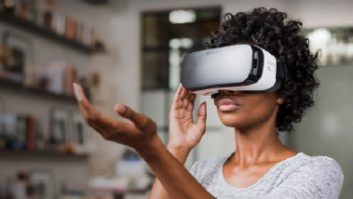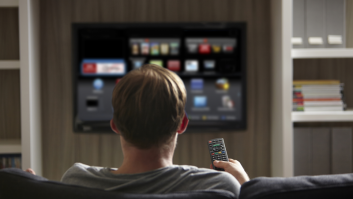
True telepresence or volumetric 3D is part of a new wave of imaging technologies set to revolutionise the way we communicate.
The initial applications for systems which promise live realtime 3D autostereoscopic viewing will be in the corporate videoconferencing sector where 3D Telepresence systems are claimed to provide a realistic feeling of face to face presence including direct eye contact.
Hungarian display developers Holografika have devised the HoloVizio C80 (pictured), a front-projected autostereo system that provides a 3 metre wide 3D image. Instead of delivering the two views (left and right eye) of stereoscopic systems, the HoloVizio display generates a whole 3D light-field with, it’s claimed, no jumps between views and a fully continuous motion parallax.
“The approach we use is different from that of stereoscopic, multiview, volumetric and holographic systems,” explained CTO Péter Kovács. “The 3D image can be seen with unassisted naked eye for multiple viewers simultaneously. There are no side effects, like discomfort or eyestrain, and no invalid zones.”
A demonstration has been conducted using a rig of 27 CCD cameras capturing a combined 18MPixels. Holografika’s display emits light beams of different colour and intensity to various directions and composes the images into a continuous 3D view. “We consider this a major step towards the implementation of real 3D telepresence,” said Kovács, who notes that it is still in experimental stage. “Real-time capture, transmission and rendering is working fine,” he said. “There are some technical challenges to be solved: latency, better compression, placement of cameras, but we are getting closer and closer.”
An alternate system has been devised under the EU funded 3DPresence project which is backed by Telefonica Research, Fraunhofer-HHI, Philips Research, Radvision and Eindhoven University.
This system works with a special lenticular screen which renders autostereoscopic experience in two perspectives. Viewers sitting to the left and to the right the screen each receive a multiview comprised of 15 views, but at different perspectives from each other, relative to the viewer’s position in the room.
“These perspectives give a more realistic sense of in room presence,” explained Oscar Divorra Escoda of Telefonica Research. “We have proof of concept but a reduction in the price of the screens is required for us to go mass market.”
Aside from videoconferencing applications for such systems include oil & gas exploration; surgical planning; museums and theme parks; simulation and air traffic control; security, such as 3D luggage scanning; scientific visualization; CAD and gaming.
US developer Digital Video Enterprises (DVE) markets an Immersion Room which features a high brightness projector built into a conference table which projects HD1080 60fps video onto a 120-inch anti-reflective screen which beamsplits the image to create a 3D illusion. Conferees in another location are captured by a single HD camera against chroma key or blackened wall.
At a cost of U$1.1m for custom installs the system isn’t cheap, but on a par with existing commercial telepresence systems from Cisco or Polycom.
Jeff Machtig, co-founder of DVE, prefers the term volumetric 3D to describe the effect of DVE’s technology, noting that the terms 3D and holographic telepresence have become muddled as companies try to differentiate their products.
“We have been developing this technology for a decade and we are pleased to see that the market is finally emerging,” he said







